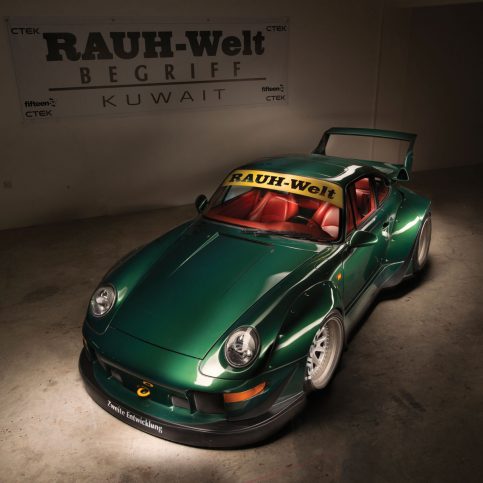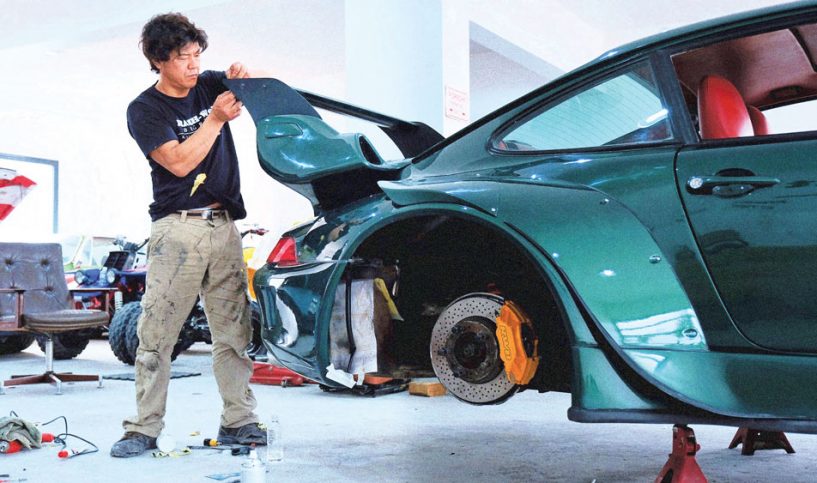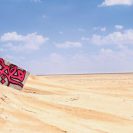In an unmarked repairs garage, hidden from prying eyes and the heavy traffic of the Shuwaikh Industrial area, we found ourselves standing in front of a vintage, air-cooled, beautiful deep forest green Porsche 911. Piece by piece, we watched as the car went from the very familiar Porsche 911, to a one-of-a-kind Rauh Welt Begriff custom design. A small dog ran around, unfazed by the loud bangs and whizzes of the machinery as a man, single handedly, sat at the base of the car and expertly poked and prodded at it with silicone binding and rubber sheets. This man, world-renowned Japanese Porsche 911 customizer, founder of Rauh Welt Begriff (RWB) and the proud creator of the Stella Artois, was none other than Akira Nakai a.k.a., Nakai-san.
Six-months prior to the famed customizer’s flight to Kuwait, the local owner of the Porsche 911 contacted Akira and provided him with the car’s specs. Intrigued by the 1st request from Kuwait, Akira took the specs and suggested a self-designed kit which includes sideskirts, a racing wing, other noticeable extras and the color of the car itself. The shipped parts are only ever added on by Nakai-san during his visit. As for the custom tire rims, they were shipped in from US-based specialists, Fifteen52. But to understand how this project came to be, you need to understand Nakai-san.
Grease stains and residual silicone covered his hands as he pondered his next move, and he glided from one side of the car to the other. “He only uses what’s made available to him,” a voice explained in the background, “Akira has a talent to create something spectacular from what’s available and what he has planned for.” Akira, unperturbed by the noise, blissfully sifted through a pile of bolts, found the missing piece to his hyperbolic puzzle, and placed it in its rightful spot.
No blueprints, plans or notes were anywhere in sight. As I wondered how the project was going to come together, Akira spoke. “I don’t come here with an idea. The idea comes to me when I start working.” Baffled by the notion, he further explained, “I know the specs of the car from before and I already made the parts I want to attach. So when I see the car, I can adapt a design that would work.” His progression was unlike any other, and it was fascinating having watched him craft his creation. While the style of his cutting and wielding of parts seemed brash from a distance, up-close there was an expertise to the flicks of his wrist, however, as he maneuvered the electric saw from one end to the other.
Nakai-san draws inspiration from his surroundings and is influenced by everything he comes in contact with. From the moment he sets foot in the country he’s working in, to the test drive he takes his completed project on, Akira is consistently buzzing with ideas. He listened to whatever local music and radio his hosts listened to, ate machboos and fatayer for the duration of his stay, and indulged in whatever pastimes were made available to him.

Soaking in as much of the local customs and culture as he possibly could, Akira loved every second of it and reflected his admiration in the final product. He worked away furiously, not an instant was wasted as Akira stuck, removed, added and cut through the parts. It’s worth mentioning that the entire project was done in the span of one single weekend.
He began his work with spare parts and ended the weekend with a leisurely drive at hyper-speed and with epic drifts to check the functionality of his creation. Akira leaves no spec or turn for chance before he leaves. A mechanic-turned-drifter and race-car driver, Akira understands the car’s requirements for efficiency. As a builder and creator, his appreciation for aesthetics makes for interesting design elements. Combining his two passions, the results are astounding in both intent and execution. Having previously worked on his own vehicle, the Stella Artois, to perfect his drifts and increase stability and speed, Akira’s flourishes and additions turned from a necessity to an exaggerated representation, that gave the vehicle its iconic look. From there, he rose from drifter and racer to creator and icon-extraordinaire. But his humble disposition rejects the notion of this status, as Akira insists he does it out of love.
As someone that lives in an entirely analog world, Akira prefers to do most of his interactions face-to-face. The only time he would consider using technology is when he’s communicating with his next client, otherwise, all calculations are done by hand – on pen and paper. When asked about the number of projects he’s done, he simply shrugs. But we’ve managed to figure out that he’s worked on at least 300 cars over the span of his career – and more than 60 in 2015 alone!
When one contacts Akira, they’re essentially buying a look and feel for the car. How it drives later depends on how Akira puts it together and the exterior modifications he’s implemented to his design – the interior is entirely up to you. But exterior design isn’t the only thing that lends Akira’s work its status, we’re told the name is a huge part of it. The allure of naming the car at the end imparts a strength and mystique to the vehicle. As it’s engrained in Japanese culture that names hold a sanctity and power, the car gains its sway when Akira bestows a name upon it. But the name doesn’t come through a thoughtless process. On the contrary, Akira waits till the project is complete, and lets the car guide the inception of its name. For the duration of the weekend, it was all people would talk about. Whispered wonderings of what the possible name would be rang throughout the garage as Akira worked in silence. We watched him with fascination, as he carefully inspected every inch of the car, but nothing had everyone on edge as much as the wait to uncover the car’s name.

With the name hanging in the air, Akira continued to diligently work on the car until he was ready to attach the wheels. The custom rims were created to not only mirror the authentic feel of this vintage Porsche, but to accommodate the modifications impeccably. Once the reformations came to an end, Akira took it out for a spin to listen to every shake, rattle and ding – or lack thereof – to ensure the quality of ride. As it delicately purred away, the project was deemed complete and the customization process a success. And the name? With all the influences that were present around Akira as he built this custom-beauty, the name came to him easily. And as the project wrapped up, Akira dubbed this one-of-a-kind Rauh Welt Begriff creation: Farukon – Japanese for falcon.
This is some of the behind-the-scenes footage of the project in action:
You can contact Akira by visiting his website www.rauh-welt.com, or follow @garage_shuwaikh on Instagram for more information about getting your car pimped out here in Kuwait.
Akira’s photos by Yousef Al Nasser – Instagram @yousefcam.
Photo of the Farukon by Ebrahim Alawadi – Instagram @EAPhotology.











